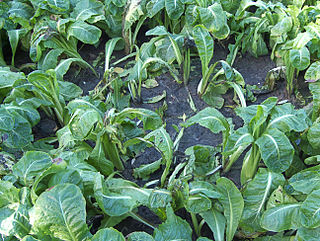
Pseudomonas is a genus of Gram-negative, Gammaproteobacteria, belonging to the family Pseudomonadaceae and containing 191 described species. The members of the genus demonstrate a great deal of metabolic diversity and consequently are able to colonize a wide range of niches. Their ease of culture in vitro and availability of an increasing number of Pseudomonas strain genome sequences has made the genus an excellent focus for scientific research; the best studied species include P. aeruginosa in its role as an opportunistic human pathogen, the plant pathogen P. syringae, the soil bacterium P. putida, and the plant growth-promoting P. fluorescens, P. lini, P. migulae, and P. graminis.
Pseudomonas agarici is a Gram-negative soil bacterium that causes drippy gill in mushrooms. It was first isolated in New Zealand. P. agarici could not be grouped based on 16S rRNA analysis, so it is designated incertae sedis in the genus Pseudomonas.
Pseudomonas avellanae is a Gram-negative plant pathogenic bacterium. It is the causal agent of bacterial canker of hazelnut. Based on 16S rRNA analysis, P. avellanae has been placed in the P. syringae group. This species was once included as a pathovar of Pseudomonas syringae, but following DNA-DNA hybridization, it was instated as a separate species. Following ribotypical analysis Pseudomonas syringae pv. theae was incorporated into this species.
Pseudomonas corrugata is a Gram-negative, plant-pathogenic bacterium that causes pith necrosis in tomatoes. Based on 16S rRNA analysis, P. corrugata has been placed in the P. fluorescens group. For a more comprehensive phylogenetic analysis of P. corrugata and its closely related phytopathogenic bacterium P. mediterranea, refer to Trantas et al. 2015.

Pseudomonas marginalis is a soil bacterium that can cause soft rots of plant tissues. It infects poinsettia, lettuce, and crucifers.
Pseudomonas mendocina is a Gram-negative environmental bacterium that can cause opportunistic infections, such as infective endocarditis and spondylodiscitis, although cases are very rare. It has potential use in bioremediation as it is able to degrade toluene. Based on 16S rRNA analysis, P. mendocina has been placed in the P. aeruginosa group.
Pseudomonas anguilliseptica is a Gram-negative bacterium that is pathogenic to fish. It was first isolated from Japanese eels. Based on 16S rRNA analysis, P. anguilliseptica has been placed in the P. aeruginosa group.
Pseudomonas flavescens is a Gram-negative bacterium that causes blight cankers on walnut trees. Based on 16S rRNA analysis, P. flavescens has been placed in the P. aeruginosa group.
Pseudomonas mosselii is a Gram-negative, rod-shaped, bacterium clinically isolated in France. Based on 16S rRNA analysis, P. mosselii has been placed in the P. putida group.
Pseudomonas straminea is a Gram-negative, rod bacterium that includes strains formerly identified as P. ochracea. Based on 16S rRNA analysis, P. straminea has been placed in the P. aeruginosa group.
Pseudomonas lundensis is a Gram-negative, rod-shaped bacterium that often causes spoilage of milk, cheese, meat, and fish. Based on 16S rRNA analysis, P. lundensis has been placed in the P. chlororaphis group.
Pseudomonas mucidolens is a Gram-negative, non-sporulating, motile, rod bacterium that causes mustiness in eggs. Based on 16S rRNA analysis, P. mucidolens has been placed in the P. fluorescens group.
Pseudomonas plecoglossicida is a non-fluorescent, Gram-negative, rod-shaped, motile bacterium that causes hemorrhagic ascites in the ayu fish, from which it derives its name. Based on 16S rRNA analysis, P. plecoglossicida has been placed in the P. putida group.
Pseudomonas cedrina is a Gram-negative, rod-shaped bacterium isolated from spring waters in Lebanon. Based on 16S rRNA analysis, P. cedrina has been placed in the P. fluorescens group.
Pseudomonas orientalis is a Gram-negative, rod-shaped bacterium isolated from spring waters in Lebanon. Based on 16S rRNA analysis, P. orientalis has been placed in the P. fluorescens group.
Pseudomonas mandelii is a fluorescent, Gram-negative, rod-shaped bacterium isolated from natural spring waters in France. Based on 16S rRNA analysis, P. mandelii has been placed in the P. fluorescens group.
Pseudomonas gessardii is a fluorescent, Gram-negative, rod-shaped bacterium isolated from natural mineral waters in France. Based on 16S rRNA analysis, P. gessardii has been placed in the P. fluorescens group.
Pseudomonas costantinii is a Gram-negative bacterium that causes brown blotch disease in cultivated mushrooms. It demonstrates hemolytic activity. The type strain is CFBP 5705.
Tolaasin, a toxic secretion by Pseudomonas tolaasii, is the cause of bacterial brown blotch disease of edible mushrooms. Tolaasin is a 1985 Da lipodepsipeptide non-host specific toxin. In addition to forming an amphipathic left handed alpha-helix in a hydrophobic environment, the toxin has been shown to form Zn2+-sensitive voltage-gated ion channels in planar lipid bilayers and to catalyze erythrocyte lysis by a colloid osmotic mechanism. At high concentrations, tolaasin acts as a detergent that is able to directly dissolve eukaryotic membranes.[1]
Brown blotch disease is a bacterial infection that affects nearly every species of mushroom. The infecting bacteria, Pseudomonas tolaasii, produces the toxin tolaasin that causes brown spots to cover the surface of the mushroom. Brown blotch disease is especially problematic on common mushroom farms, where it can spread quickly and cause huge economic losses.

